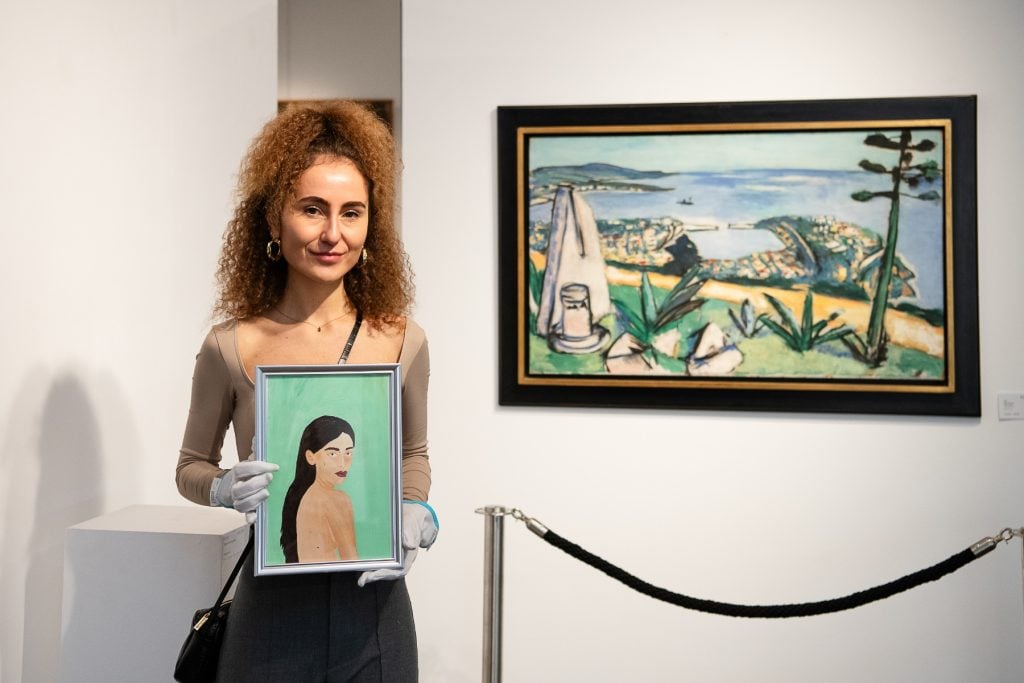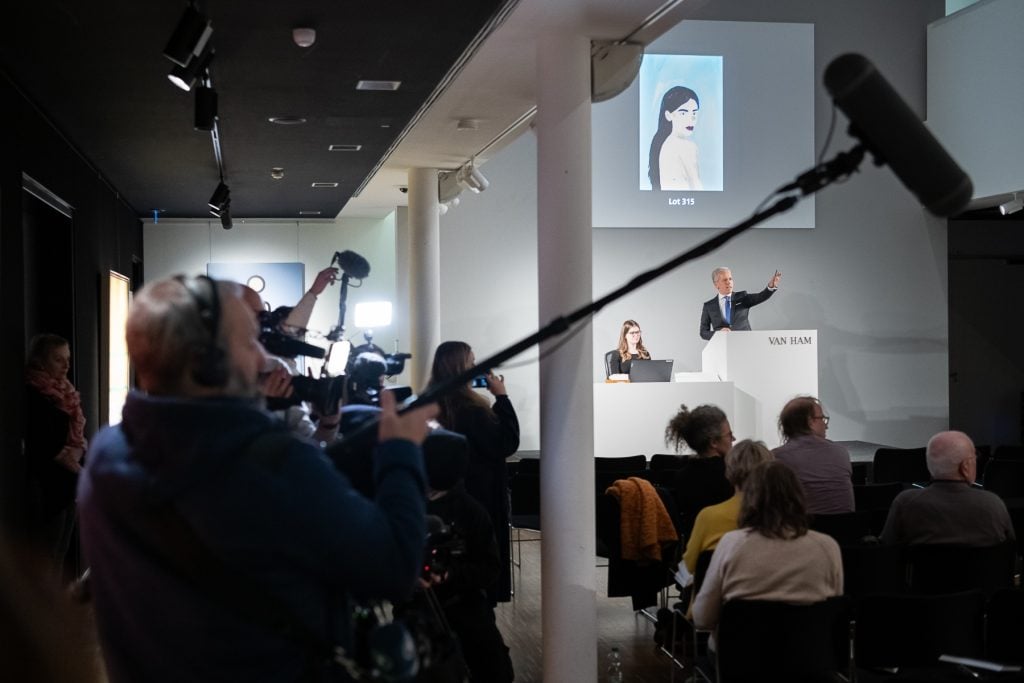Museums & Institutions
A Short History of Artists Sneaking Their Work Into Museums
An aspiring artist hung her own painting at a museum show and later sold the work at auction. Not all have been so lucky.

An aspiring artist hung her own painting at a museum show and later sold the work at auction. Not all have been so lucky.

Jo Lawson-Tancred &
Margaret Carrigan

An aspiring artist who made his living working for the modern art museum in Munich must have harbored dreams of fame and adulation when he hatched a plot to secretly put his own work on the walls. Unfortunately, his bosses did not see this as a legitimate way to gain a prestigious exhibition history. He has been fired and is banned from ever returning to the museum. Yet he’s one of several artists to covertly install their own work in a museum, although others have perhaps found better luck with their curatorial interventions.
The anonymous man, aged 51, was working as a technician at the Pinakothek der Moderne when he snuck into the museum ahead of opening hours on February 23 and mounted his own painting on the wall. Measuring about 24 by 48 inches and hanging in a passageway, the work was briefly on view alongside the collection’s other masterpieces by artists like Anselm Kiefer, Cy Twombly, Francis Bacon, and Gerhard Richter.
Local police told the Süddeutsche Zeitung that the man had apparently acted “in the hope of achieving his artistic breakthrough.”

General view of the installation from artist Victor Ehikhamenor at the Pinakothek der Moderne on May 21, 2021 in Munich, Germany. Museum and cultural spaces across Germany have reopened their doors as the country starts lifting restrictions aimed at preventing the spread of coronavirus. Photo: by Hannes Magerstaedt/Getty Images.
Just a few hours later, the curators spotted this mysterious addition to their permanent collection and took it down. A spokesperson told the Guardian that this was done at 6pm, after the public had left. The incident, which was only made public on Monday, soon became the subject of a police investigation.
“Employees must adhere to strict security concepts and must not put valuable cultural assets at risk,” a spokesperson for the Pinakothek der Moderne said via email. “The presentations and exhibitions at the Pinakothek der Moderne are characterized by a passion for the present and for current and relevant artistic movements. The juxtapositions and dialogues of the works are carefully composed by the curators for the public and out of collegiality and respect for their academic work may not be arbitrarily changed or expanded for selfish motives.”
Yet, a sly student in the Germany city of Bonn did secure a bit of a breakthrough when she snuck her painting into the Bundeskunsthalle last year, sticking it to the wall with double-sided tape. The curators only realized something was amiss when they dismantled the temporary exhibition “Who We Are. Reflecting a Country of Immigration” in October and were surprised to find an extra painting on their hands.

Danai Emmanouilidis’s painting Georgia is sold at Van Ham auction house in Cologne after she snuck it onto the wall of an exhibition at the Bundeskunsthalle in Bonn, Germany. Photo courtesy of Van Ham.
Taking to X (formerly Twitter), the museum applauded the mischievous initiative. “We think this is funny and would like to know the artist,” a spokesperson wrote. “So get in touch! There will be no trouble. Word of honor.”
The artist, Danai Emmanouilidis, eventually came forward and her painting was later sold for €3,696 ($4,000) at Van Ham auction house in Cologne on November 30. The proceeds went to the art charity ArtAsyl.
One of the best-known artists in the world, Banksy, has also leveraged guerrilla displays to great effect. In 2003, the graffiti artist entered Tate Britain disguised as a pensioner and stuck one of his own paintings to a gallery wall. Titled Crimewatch UK Has Ruined the Countryside For All of Us, it depicted an idyllic country scene marred by lines of blue and white police tape and was hung next to a 19th century landscape. Regrettably, the painting fell after a few hours, alerting security to the stunt.
The museum launched an investigation, but the artist, who was fast becoming a celebrity at that time, had achieved notoriety for his sneaky installation.
“To actually go through the process of having a painting selected must be quite boring,” Banksy said in a statement to the Guardian. “It’s a lot more fun to go and put your own one up. It’s all about cutting out the middle man, or the curator in the case of the Tate.”
Perhaps of all the artists to attempt this act, no one was more persistent than the Israeli artist Eliezer Sonnenschein, who spent much of the 1990s sneaking his work into the Tel Aviv Museum of Art, replacing his renegade pieces each time they were removed by museum staff. In 1996, Ellen Ginton, a senior curator at the museum, saw a work she decided she liked: Sonnenschein had left a small sculpture depicting poop on top of pasta and a box of cigarettes. She invited him to leave the work and be a part of the exhibition. Sonnenschein’s career blossomed, and the Swiss curator Harald Szeemann included his work in the 2001 Venice Biennale.
But even before Sonnenschein, conceptual artist Dove Bradshaw affixed a homemade label near a fire hose in the Metropolitan Museum of art in 1976, claiming it as her work and calling it, appropriately, Fire Extinguisher. In 2007, the Met acquired the label as an artwork for its permanent collection.
Unlike these other artists, the recent opportunistic auteur in Munich has yet to find a curatorial champion. Hoping to avoid “copycat pranksters,” the museum refused to reveal any information about the artwork to the Guardian. A spokesperson claimed, however, that the museum “did not receive any positive feedback on the addition from visitors to the gallery.”
Luckily for the artist, hanging your own art inside a museum is not a crime in Germany. After he was fired for hanging his work, however, he was eventually charged with damage to property for drilling two holes into the wall, a relatively minor offense.